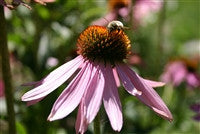Often called Coneflower, Echinacea is probably the most recognized and important native North American medicinal plant. Growing in central and eastern North America, echinacea varieties have been enthusiastically adopted into European, Ayurvedic and traditional Chinese medicine. The three most important species, whose medicinal qualities are more or less equivalent, are Echinacea purpurea, angustifolia and pallida.
Echinacea’s most common use is to treat upper respiratory tract infections. Trials have shown that coneflower significantly reduces the length and severity of colds and thus it is often recommended at the first sign of a cold. Besides being a strong immune stimulant, recent research has found that it reduces inflammation resulting from viruses. In fact, herbalists refer to echinacea as the wonder herb for all acute inflammatory conditions, generally being mild enough so there are no side effects.
Coneflower root tea was used externally by First Nations to treat sores, wounds, burns and bites. It was considered a blood purifying plant and the root tea was brewed for acne, boils, canker sores and eczema. The root was chewed to relieve toothaches and to aid digestion.
Echinacea’s flowers make a gorgeous garden addition. Coneflowers are stunning perennials and they attract many bees and butterflies. Purple petals surround bristly orange cones on 3-4 foot stems. The orange seed heads turn black in the fall. Seeds can be harvested by cutting the heads, allowing them to dry for a week and then shaking them in a closed container to release the white seeds that look like little wood chips.
Echinacea is easiest to grow as transplants by starting the seeds in warm or cool flats in early spring. Water well the first year but, once established, echinacea is very drought-resistant. Seeds can also be direct sown in late summer.
Coneflowers can be grown in well-drained soil with full or partial sun. They tolerate poor rocky soil but do not like wet, mucky ground. They bloom midsummer to fall and tolerate both heat and light frost. They should be spaced a foot or more apart. Cut them back in late winter or early spring when you’re tidying up the garden.
Roots are normally harvested in fall of the third year. When making tincture, it is best to use the fresh roots quickly, ideally within 24 hours.


